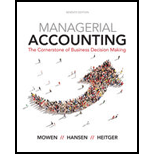
1.
Compute inherent risk.
1.
Answer to Problem 20BEA
Inherent risk is $24,000,000.
Explanation of Solution
Inherent Risk:
Inherent risk is a risk that prevails in a system before any control measure is adopted within an organization.
Computation of inherent risk:
Inherent risk can be computed by using the following formula:
Substitute $80,000,000 for impact and 30% for the probability of occurrence in the above formula.
Therefore, inherent risk is $24,000,000.
2.
Compute residual risk of each of the three alternatives.
2.
Answer to Problem 20BEA
Residual risk for alternative A, B, and C is $16,000,000, $7,500,000, and $24,000,000 respectively.
Explanation of Solution
Residual risk can be computed by using the following formula:
Computation of residual risk for alternative A:
Substitute $80,000,000 for impact and 20% for the probability of occurrence in the above formula.
Computation of residual risk for alternative B:
Substitute $50,000,000 for impact and 15% for the probability of occurrence in the above formula.
Computation of residual risk for alternative C:
Substitute $80,000,000 for impact and 30% for the probability of occurrence in the above formula.
Therefore, residual risk for alternative A, B, and C is $16,000,000, $7,500,000, and $24,000,000 respectively.
3.
Compute benefit from each of the three alternatives.
3.
Answer to Problem 20BEA
Benefitfrom alternatives A, B, and C is $8,000,000, $16,500,000, and $0 respectively.
Explanation of Solution
Benefit from a risk response alternative can be computed by using the following formula:
Computation of response benefit from alternative A:
Substitute $24,000,000 for inherent risk and $16,000,000 for residual risk in the above formula.
Computation of response benefit from alternative B:
Substitute $24,000,000 for inherent risk and $7,500,000 for residual risk in the above formula.
Computation of response benefit from alternative C:
Substitute $24,000,000 for inherent risk and $24,000,000 for residual risk in the above formula.
Therefore, benefit from alternatives A, B, and C is $8,000,000, $16,500,000, and $0 respectively.
4.
Compute net benefit from each of the three alternatives.
4.
Answer to Problem 20BEA
Net benefit from alternatives A, B, and C is $5,000,000, $3,500,000, and $0 respectively.
Explanation of Solution
Net benefit from a risk response alternative can be computed by using the following formula:
Computation of net benefit from alternative A:
Substitute $8,000,000 for response benefit and $3,000,000 for response cost in the above formula:
Computation of net benefit from alternative B:
Substitute $16,500,000 for response benefit and $13,000,000 for response cost in the above formula:
Computation of net benefit from alternative C:
Substitute $0 for response benefit and $0 for response cost in the above formula:
Therefore, net benefit from alternatives A, B, and C is $5,000,000, $3,500,000, and $0 respectively.
5.
Identify the alternative which would be adopted by the company.
5.
Explanation of Solution
Alternative A would be chosen by the company since; net benefit is highest in case of alternative A.
Want to see more full solutions like this?
Chapter 13 Solutions
Managerial Accounting
- Swamy Stationery Inc. budgeted production of 64,000 planners in 2023. Paper is required to produce a planner. Assume 95 square yards of paper are required for each planner. The estimated January 1, 2023, paper inventory is 400,000 square yards. The desired December 31, 2023, paper inventory is 370,000 square yards. If paper costs $0.14 per square yard, determine the direct materials purchases budget for 2023. Answerarrow_forwardCan you explain the correct approach to solve this financial accounting question?arrow_forwardWhich cost is classified as a product cost? (a) Selling expenses (b) Marketing expenses (c) Administrative expenses (d) Direct materials MCQarrow_forward
 Managerial Accounting: The Cornerstone of Busines...AccountingISBN:9781337115773Author:Maryanne M. Mowen, Don R. Hansen, Dan L. HeitgerPublisher:Cengage Learning
Managerial Accounting: The Cornerstone of Busines...AccountingISBN:9781337115773Author:Maryanne M. Mowen, Don R. Hansen, Dan L. HeitgerPublisher:Cengage Learning Essentials of Business Analytics (MindTap Course ...StatisticsISBN:9781305627734Author:Jeffrey D. Camm, James J. Cochran, Michael J. Fry, Jeffrey W. Ohlmann, David R. AndersonPublisher:Cengage Learning
Essentials of Business Analytics (MindTap Course ...StatisticsISBN:9781305627734Author:Jeffrey D. Camm, James J. Cochran, Michael J. Fry, Jeffrey W. Ohlmann, David R. AndersonPublisher:Cengage Learning Intermediate Accounting: Reporting And AnalysisAccountingISBN:9781337788281Author:James M. Wahlen, Jefferson P. Jones, Donald PagachPublisher:Cengage Learning
Intermediate Accounting: Reporting And AnalysisAccountingISBN:9781337788281Author:James M. Wahlen, Jefferson P. Jones, Donald PagachPublisher:Cengage Learning Excel Applications for Accounting PrinciplesAccountingISBN:9781111581565Author:Gaylord N. SmithPublisher:Cengage Learning
Excel Applications for Accounting PrinciplesAccountingISBN:9781111581565Author:Gaylord N. SmithPublisher:Cengage Learning




